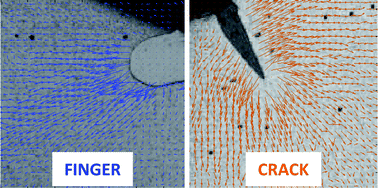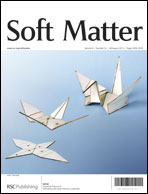The fingering to fracturing transition in a transient gel
Abstract
Fracture processes are ubiquitous in soft materials, even in complex fluids, subjected to stress. To investigate these processes in a simple geometry, we use a model self-assembled transient gel and study the instability patterns obtained in a radial Hele-Shaw cell when a low viscosity oil pushes the more viscous transient gel. By analyzing the morphology of the patterns, we find a discontinuous transition between the standard Saffman–Taylor fingering instability and a fracturing instability as the oil injection rate increases. Our data suggest that the flow properties of the gel ahead of the finger tip controls the transition towards fracturing. By analyzing the displacement field of the gel in the vicinity of the fingers and cracks, we show that in the fingering regime, the oil gently pushes the gel, whereas in the fracturing regime, the crack tears apart the gel, resulting in a strong drop of the gel velocity ahead of the crack tip as compared to the tip velocity. We find a unique behavior for the whole displacement field of a gel around a crack, which is drastically different from that around a finger, and reveals the solid-like behavior of the gel for short time. Our experiments and analysis provide quantitative yet simple tools to unambiguously discriminate a finger from a crack in a visco-elastic material.


 Please wait while we load your content...
Please wait while we load your content...